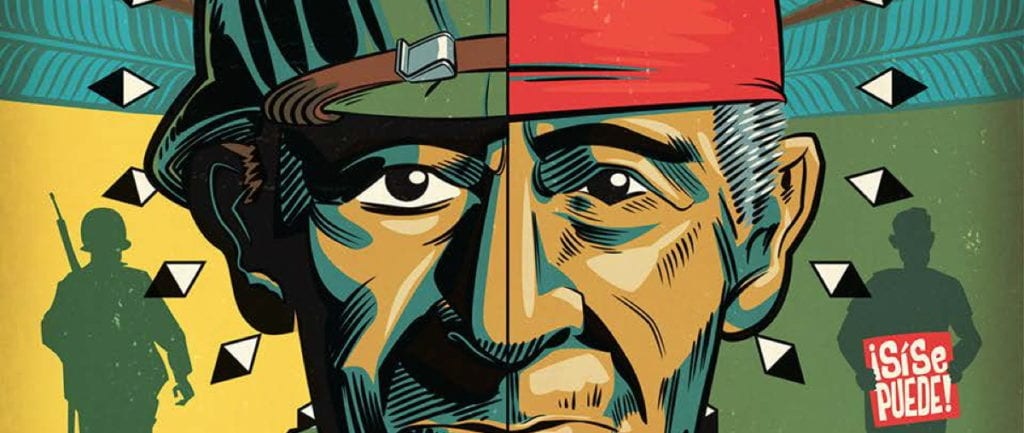
It is easy to forget the panoply of possible genres for comics; in a field saturated with superheroes even those of us who avidly follow the indie scene can forget that some of the greatest works of sequential art – from Maus to Persepolis – are those that have drawn on the real world and the lived experiences of the writers or their families. Comics have the uncanny ability to connect to a reader on many levels, and the very act of reading comics forces us to do part of the work of the storytelling within our own minds. This makes them ideal for historical and biographical stories, because the multivalent nature of comics can draw the reader into deeper engagement with the material.
La Voz de M.A.Y.O. Tata Rambo (hereafter referred to as Tata Rambo) demonstrates the power of the form to do just this. Writer Henry Barajas adopts an intriguing perspective for telling this story; as a trained journalist, the comic is riddled with the kind of research and insights an investigative reporter would seek out, a sequential art documentary uncovering the story of his great-grandfather, Ramon Jaurigue. However, this journalists’ eye is melded with the admiration of a great-grandson for a great man and wedded to a sort of oral history that one might hear around a table at a family gathering. It is an unusual approach, one that yields fantastic insights and gives us a feeling of proximity to this incredible man and his story.
The story is told in scenes bursting with character; interspersed are flashbacks to Ramon’s military service and the chaotic but loving family environment he and his wife Leonor share, illustrating for the reader a man of principle and love who is deeply enmeshed in his community. At the same time, the story also depicts his organization (The Mexican American Yaqui organization) and its newsletter, a sort of guerrilla justice publication called La Voz de M.A.Y.O. As soon as news comes that freeway construction will disrupt the local Yaqui people, Ramon mobilizes M.A.Y.O. to do something about it.
Without giving away all that happens, I do want to focus specifically on an intriguing element of the story. Rallying people to Ramon’s cause is not done simply with a call to everyone, nor is there some specific protocol. Instead, Ramon extends his hands out through his community, demonstrating the organizational power of non-hierarchical social and cultural institutions to mobilize for action. At a social party, a baseball game where he coaches, anywhere he can make connections, Ramon animates people to action not only by his appeal to their sense of justice but also because he is a man of respect, a man of standing in the community who can use his experience and social position effectively. Anyone who has lived in communities like this understands that not every person has to be elected or hold official power; there are other forms of influence that are more efficacious, and more noble.
As a trained historian, I was immediately drawn to the connections to the wider labor and social justice movements which are deftly woven into the narrative. In my years of studying frontiers and borderlands I have come to understand that the border is a complicated space that defies the easy delineations of political lines and boundaries. Instead, the border is a place of transgressive action, where political realities are rendered fictive in relation to the social, cultural, and economic crossroads that defines these spaces. Borderlands are susceptible to all the same sorts of exercises of coercive power, but undermine straightforward implementations and resist facile attempts to organize them. A border is a trenchant, powerful place that uses the vagueness of historical definitions and the overlapping of long-held conceptions to complicate any story or event that takes place there. Tata Rambo illustrates this beautifully, with Ramon moving in a variety of environments and arenas to pursue his goal.
I would be remiss to not mention the art by J. Gonzo; the entire story has the sensibilities of a painting, with colors that evoke the environments of Southern Arizona and seem to celebrate the tones of the people, teeming with rich browns and blacks. My favorite pieces, though, are probably the images of protest, where riotous splashes of color capture the chaos and excitement, and where the stark use of lighting frames the opposition the people face. Ramon himself seems to be perpetually smiling; the art does not depict some dour, grim-faced revolutionary but a man of genuine hope and love, indefatigable in his pursuit of justice.
Taken altogether, this story is critical on many levels. It is an excellent use of the medium to tell a personal story; a creative implementation of multiple perspectives; and a beautifully illustrated tale of Latinx and Native action in a time when it is desperately needed. I highly recommend it to all readers.
The team currently has an ongoing kickstarter for the second issue, here:
https://www.kickstarter.com/projects/hbarajas/la-voz-de-mayo-tata-rambo-2
